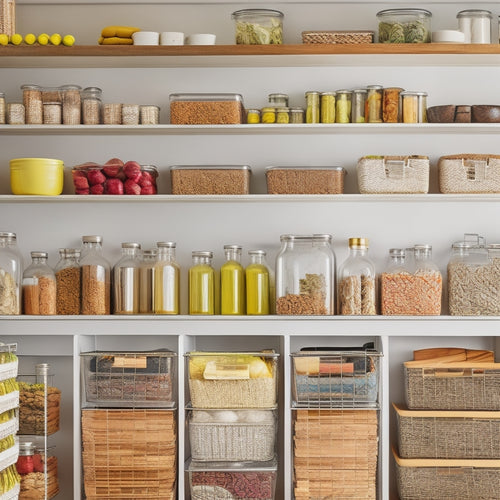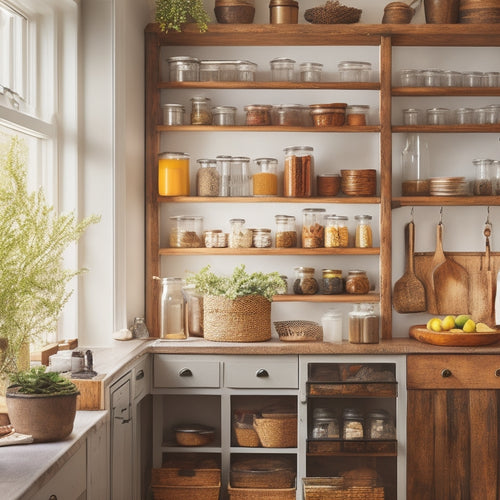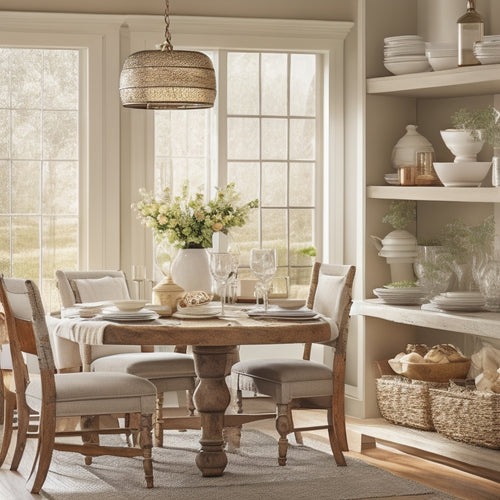
7 Best Online Courses for Kitchen Pantry Management
Share
You're about to transform your kitchen pantry into a highly functional and organized space by enrolling in one of the 7 best online courses for kitchen pantry management, where you'll learn expert strategies to declutter, optimize storage, and streamline meal planning. These courses will teach you how to categorize items, implement labeling systems, and maximize vertical space for efficient storage. You'll discover how to conduct a thorough purge, adopt a minimalist approach, and create meal plans that reduce food waste. By the end of these courses, you'll have the skills to create a pantry that's tailored to your needs, making cooking and meal prep a breeze - and that's just the beginning of your pantry transformation journey.
Key Takeaways
• Master pantry organization fundamentals by identifying primary zones, implementing labeling systems, and categorizing items for easy access.
• Learn decluttering and purge strategies to eliminate expired or unnecessary items and adopt a minimalist approach to kitchen management.
• Discover how to maximize storage space efficiency by using innovative containers, labeling systems, and optimizing shelf space.
• Develop meal planning and grocery list skills to streamline kitchen operations, reduce food waste, and save time and money.
• Establish productive pantry maintenance habits, such as regular inventory tracking, label updating, and 'first in, first out' rule implementation.
Mastering Pantry Organization Fundamentals
You start by identifying the three primary zones in your pantry: the landing strip, the bulk storage area, and the frequently used section, each serving a distinct purpose in maintaining a well-organized kitchen pantry.
The landing strip is where you place items that need to be put away, the bulk storage area is for items you buy in bulk, and the frequently used section is for everyday essentials.
Next, you implement labeling systems and organization hacks to guarantee easy access and visibility of your pantry contents. This includes categorizing similar items together, using baskets and bins to store small items, and installing shelves and racks to maximize vertical space.
To maintain your pantry's organization, you'll need to track your inventory and practice shelf rotation. This means regularly checking expiration dates, using the 'first in, first out' rule, and restocking your pantry when necessary.
Decluttering and Purge Strategies
Now that your pantry's organizational framework is in place, it's time to tackle the clutter that's been hiding in plain sight, and that starts with a thorough purge of expired, spoiled, or unnecessary items.
Take everything out of your pantry and sort items into three piles: keep, donate/sell, and discard. Be ruthless – if you haven't used it in the past year, it's likely safe to get rid of it.
As you declutter, adopt a minimalist approach and focus on mindful consumption. Ask yourself, 'Do I really need this?' or 'Can I replace it if I need it again?'
Consider sustainable living and the environmental impact of your food choices. If you find expired or spoiled items, dispose of them properly and take note of what you can do differently in the future.
Use organizing hacks like the 'first in, first out' rule to ensure older items are used before newer ones. Check expiration dates and store items accordingly.
Maximizing Storage Space Efficiency
With your pantry decluttered and purged of unnecessary items, it's time to optimize the storage space to guarantee every inch is utilized efficiently.
Now, it's all about maximizing storage space efficiency. You'll want to incorporate space-saving hacks, such as installing shelves, baskets, or carousels that can be easily accessed. Innovative containers like stackable bins, canisters, or airtight containers will help keep items organized and visible.
Consider a labeling system that categorizes items by type, expiration date, or frequency of use. This will enable you and your family members to quickly find what you need.
To make the most of your pantry's vertical space, install shelves or storage units that go up to the ceiling. This will provide ample room for less frequently used items, freeing up lower shelves for everyday essentials.
By implementing these strategies, you'll be able to store more items in a smaller area, reducing clutter and making meal prep a breeze.
With your pantry organized and efficient, you'll be able to serve your family and friends with ease, saving time and reducing stress in the process.
Meal Planning and Grocery Lists
Creating a meal plan and corresponding grocery list helps streamline your kitchen operations, ensuring that you're only purchasing what you need and reducing food waste. This vital step in kitchen pantry management allows you to serve others more efficiently.
When it comes to meal planning, consider the following:
-
Look for budget-friendly recipes that can be meal-prepped in advance, saving you time and money.
-
Develop nutrition-focused meal plans that cater to various dietary restrictions, ensuring everyone's needs are met.
-
Plan your meals around what's already in your pantry to avoid duplicate purchases.
-
Schedule leftovers into your meal plan to reduce food waste.
-
Review and adjust your meal plan regularly to accommodate changing tastes and preferences.
Kitchen Zone Creation and Flow
Designate specific zones within your kitchen to optimize workflow, ensuring that cooking, prep, and storage areas are logically arranged to simplify your kitchen pantry management routine. This zone optimization will streamline your cooking process, reducing clutter and stress.
Start by identifying the areas where you spend most of your time in the kitchen, such as the cooking zone, prep zone, and storage zone.
Arrange each zone to facilitate a smooth flow arrangement, keeping frequently used items within easy reach. For instance, place your cooking zone near the stove, with utensils and spices conveniently located. Your prep zone should be close to the sink, with ample counter space for food preparation. Storage zones should be easily accessible, with labeled containers and shelves to keep ingredients organized.
Productive Pantry Maintenance Habits
You establish productive pantry maintenance habits by implementing a regular cleaning schedule, checking expiration dates, and restocking essentials to prevent clutter and ensure a smooth workflow. This guarantees that you have a well-organized pantry that functions efficiently, allowing you to focus on cooking and serving others.
To maintain your pantry's productivity, remember to:
-
Conduct regular inventory tracking to identify expired or low-stock items
-
Label and categorize stored food to facilitate easy access
-
Store heavy items at the bottom and frequently used items at eye level
-
Practice the 'first in, first out' rule to minimize expired or spoiled food
-
Keep a pantry notebook to track expiration dates, recipe modifications, and ingredient substitutions
Advanced Pantry Design Techniques
Optimizing your pantry's layout with advanced design techniques can greatly enhance its functionality, allowing you to efficiently access and utilize your ingredients. By applying these techniques, you'll be able to create a pantry that's tailored to your specific needs and cooking style.
First, assess your pantry's dimensions and identify the 'zones' where you'll store specific types of ingredients. For instance, you might designate a zone for baking supplies, another for canned goods, and so on.
Next, consider the 'golden triangle' principle, where you position frequently used items in easy-to-reach locations to minimize walking distances and maximize workflow.
When organizing your ingredients, categorize them by type, frequency of use, and expiration dates. Store heavy items at the bottom, with lighter ones on higher shelves to prevent accidents. Implement a 'first-in, first-out' system to make certain older items are used before they expire.
Frequently Asked Questions
Can I Customize Pantry Organization Systems for My Dietary Restrictions?
You can definitely customize pantry organization systems to accommodate your dietary restrictions. Start by meal planning around your needs, then create customized storage solutions that cater to your specific requirements, ensuring a stress-free cooking experience.
How Do I Prevent Pests From Infesting My Pantry and Stored Food?
Just like the mythical Midas, you'll turn your pantry into a golden haven by implementing pest prevention measures, maintaining a clean space, and storing food in airtight containers, rotating stock to guarantee freshness and safety.
Are There Any Eco-Friendly Pantry Storage Container Options Available?
You'll find eco-friendly pantry storage container options that align with your values, such as sustainable solutions made from recycled materials, beeswax wraps, and zero waste options like reusable glass or stainless steel containers that reduce waste and promote a healthier planet.
Can Pantry Management Courses Help With Food Allergies and Intolerances?
Think of your pantry like a puzzle: when you're dealing with food allergies and intolerances, one wrong piece can be disastrous. By learning meal planning with substitutions and implementing labeling and organization systems, you'll create a safe and harmonious kitchen environment.
Do Online Courses Offer Personalized Pantry Design Consultations?
When you enroll in an online course, you'll typically get personalized pantry design consultations, including virtual pantry walkthroughs, to address your specific pantry organization challenges and receive customized solutions tailored to your dietary restrictions.
Related Posts
-

Tiered Racks for Kitchen Pantry Organization
Tiered racks can enhance your kitchen pantry by maximizing vertical storage and increasing visibility. They help you ...
-

Creative Organization Ideas for Tight Kitchen Spaces
To create an organized kitchen in tight spaces, think upwards. Install shelves that reach the ceiling and use wall-mo...
-

Corner Cabinet Storage for Dinnerware Sets
Corner cabinet storage for dinnerware sets can change your kitchen into an organized, stylish space. By utilizing ver...


